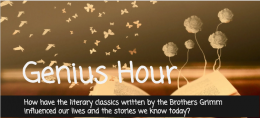This lesson is for : Grade 6:
Summary
Let your passion lead you! Research in middle school is vitally important, but is so often boring for students. Often teachers proscribe the topic or or area to be researched, but educators know if a student is engaged, better quality ensues. Genius Hour allows students to have complete control and choice as they build their research skills. Students create their own driving question, research their own topic, use a variety of forms to give feedback with other students, collaborate with students. Along the way, students reflect upon their journey of discovery.
Student chose to research such topics as “Why are gymnasts’ growth stunted?”, “Does complete silence make someone go insane?” or even “Why do I get migraines? What can I do to reduce their effect on me?” Then they must create questions to help guide their research. After conducting their research, students will synthesize the information to create a unique, authentic product and present their findings to the class in a meaningful way. , At the end of the unit, students reflect upon the process and their findings.
TIPC Ratings
Research & Information Fluency
Rating: Ideal – Explanation: Research skills and being able to find information online, in a library, and in a database is a valuable skill to learn and hone. At the heart of this unit is research. Students delve deeper to think at a higher cognitive way about research methods, which methods are ideal for their topic, what resources are considered valid and reliable, and what databases are best to use to get the most useful information. Since the research driving questions are created by the student and are real-world questions, the tasks are truly authentic for each student. Students had the ability to choose to utilize any and all of the research tools available to middle school students including online databases, all of the library resources, easybib.com, among other invaluable sources.
Communication & Collaboration
Rating: Approaching – Explanation: Students posted their possible driving questions on Edmodo to communicate with their peers. Then students provided feedback on these questions, which allowed students to engage in academic dialogue to create better questions or dismiss questions that were not as strong or manageable. All students both posted questions and comments on each others’ posts. The teacher also commented on each student’s driving questions, becoming a fellow contributor just like the students in the class. This communication allowed for the class to become a learning community. This was prominently on display when students referred fellow students to their research sources if they felt it would help someone out (from remembering their driving questions they previously posted and commented upon).
Critical Thinking & Problem Solving
Rating: Ideal – Explanation: Throughout this entire process Genius Hour, students were engaging in the process of authentic learning. Students were seeking answers to their own real world questions. This unit focuses on students creating a question, seeking out ways to solve it, and then making the choice in how to demonstrate this knowledge to others. The use of Edmodo provided students with a real world application; in the world beyond the classroom walls, people communicate and troubleshoot problems with each other in many of the same ways as they did with this project. Students were using their critical thinking and problem-solving skills when they made the decision of which tools to use for research and which digital tools to use to showcase their knowledge to the audience of learners. Students had to think from different perspectives and several steps ahead to complete Genius Hour successfully.
Creativity & Innovation
Rating: Approaching – Explanation: Students were fully engaged in this creative unit. This project allowed students to really explore whatever interested them the most. The teacher sought out to incorporate real-world 21st century research skills in a creative and innovative way. Taking the Genius Hour idea from Google, the teacher learned how education settings are using the same practice to allow students to become engaged in wherever their interests lie. The teacher provided students the opportunity to research about what they were passionate, leading to impressive results.





